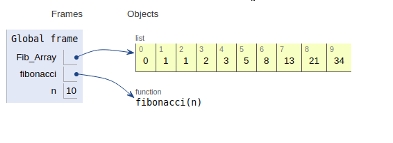
 Data Structure
Data Structure Networking
Networking RDBMS
RDBMS Operating System
Operating System Java
Java MS Excel
MS Excel iOS
iOS HTML
HTML CSS
CSS Android
Android Python
Python C Programming
C Programming C++
C++ C#
C# MongoDB
MongoDB MySQL
MySQL Javascript
Javascript PHP
PHP
- Selected Reading
- UPSC IAS Exams Notes
- Developer's Best Practices
- Questions and Answers
- Effective Resume Writing
- HR Interview Questions
- Computer Glossary
- Who is Who
Python Program for Fibonacci numbers
In this article, we will learn about the solution and approach to solve the given problem statement.
Problem statement −Our task to compute the nth Fibonacci number.
The sequence Fn of Fibonacci numbers is given by the recurrence relation given below
Fn = Fn-1 + Fn-2
with seed values (standard)
F0 = 0 and F1 = 1.
We have two possible solutions to the problem
- Recursive approach
- Dynamic approach
Approach 1 −Recursive Approach
Example
#recursive approach def Fibonacci(n): if n<0: print("Fibbonacci can't be computed") # First Fibonacci number elif n==1: return 0 # Second Fibonacci number elif n==2: return 1 else: return Fibonacci(n-1)+Fibonacci(n-2) # main n=10 print(Fibonacci(n)) Output
34
All the variables are declared in global scope as shown in the image below

Approach 2 −Dynamic Approach
Example
#dynamic approach Fib_Array = [0,1] def fibonacci(n): if n<0: print("Fibbonacci can't be computed") elif n<=len(Fib_Array): return Fib_Array[n-1] else: temp = fibonacci(n-1)+fibonacci(n-2) Fib_Array.append(temp) return temp # Driver Program n=10 print(fibonacci(n)) Output
34
All the variables are declared in global scope as shown in the image below

Conclusion
In this article, we learnt about the approach to compute Fibonacci numbers

Advertisements